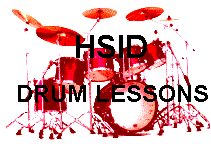Bill Powelson's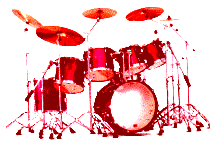 School of Drums
School of Drums

PRIVATE DRUM LESSON 2 E-M
Blues Beat Variations and Fills
'Blues' is a nickname, or street name for the following
basic dance beat family. There are more than 16,000,000 ways to alter,
or vary this basic drumset rhythm. You'll need at least a handful of these
variations when playing modern music styles.
6/8 Blues:
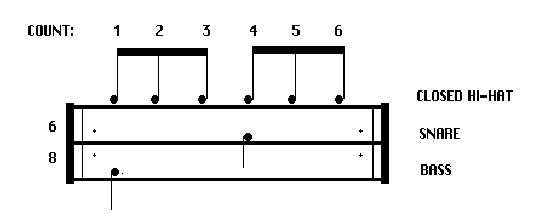
 Hear the Basic Blues beat.
Hear the Basic Blues beat.
This dancebeat may tend to take on several other technical
names, depending on how it is written. It may be written and referred
to as 6/8 or 12/8 (Blues). The 12/8 version includes two repetitions
of the pattern. This beat may also be written and referred to as a
triplet 2/4 or triplet 4/4 (Blues). The 4/4 version includes two
repetitions of the pattern.
The 6/8 (or triplet 2/4) versions contain 4,896 possible variations like the examples below.
Variation Examples:
EXAMPLE #1:
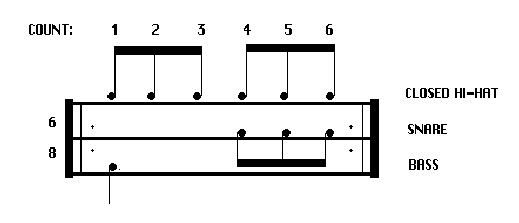
 Hear it!
Hear it!
EXAMPLE #2:
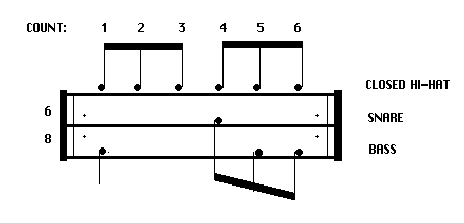
 Hear it!
Hear it!
EXAMPLE #3:
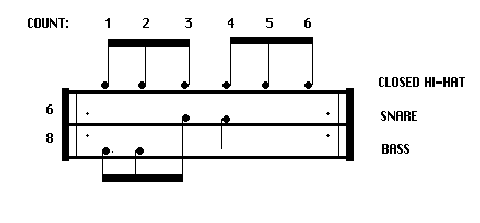
 Hear it!
Hear it!
It is common to inject variations like the examples above,
into a basic blues beat pattern in progress. In other words, try
playing several repetitions of basic blues then play one repetition
of a variation and return to the basic pattern.
Later on as you become more proficient with 8th rock
syncopations, you will discover that it is easy to adapt many
syncopations to the blues beat as well. There are approximately
16 million syncopated possibilities within every measure of a
typical 12/8 Blues song. The good news is, only a handfull
of those rhythms are commonly used.
EXAMPLE #4: Typical Blues Sync.
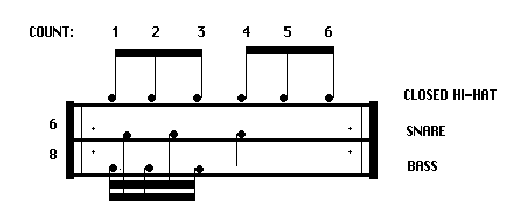
 Hear it!
Hear it!
 Hear all the blues variations in sequence.
Hear all the blues variations in sequence.
LESSON PROJECT:
Practice these patterns with a 6/8 blues tune that suits your personal taste. Try several different songs that fall into this rhythm framework. Listen to the drummer on the recording and try to imitate the patterns being played. You should get the hang of it quickly.
*** ADDING FILLS ***
DROPPING FILLS INTO 6/8 BLUES:
Adding fills to 6/8 blues is tricky. Probably the best way to begin is with 'half measure' fills.
Play the blues beat VERY slowly and count 1, 2, 3, 4, 5, 6 as you repeat the beat pattern over and over. You will want to drop your fill on
the numbers 4, 5, & 6, then return to the hi-hat as you begin the next beat repetition on the count of 1.
As an example, we will try a single stroke fill like the one below:
r=right
l=left
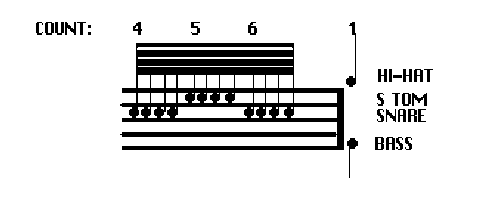
 Hear it!
Hear it!
I will try to explain the above fill example.
Begin on the snare, play four notes (rlrl), move up to the tom
and play four notes (rlrl) then back to the snare with four (rlrl) more.
Follow through to the hi-at (or ride cymb.) after the third repetition of the roll. Connect with the cymbal and bass simultaneously on the count of one.
Practice the above fill until you can play it rapidly, then try
other configurations and connect them to a blues beat in progress as shown below:

 Hear it!
Hear it!
Note: In the example above the simultaneous cymbal and bass
at the end of the fill *IS* the beginning of the next beat repetition,
or count of one.
Though we have played a single stroke fill in the above example, the roll could be ANY roll, like triplets (lrl rlr lrl), paradiddles
(lrllrlrrlrll), doubles (rrllrrllrrll). Rolls like flams, ruffs, press
rolls and others may also be used in exactly the same way. Simply drop
your chosen fill on the numbers 4, 5, and 6 and return to the beat on the
count of one.
Remember to keep the beat pattern *VERY* slow and steady! The fills will seem extremely fast compared to the slow beat.
Later on you may want to try playing 'whole measure' fills. To do 'whole measure' fills you would play six repetitions of the chosen roll. One for each count in the beat. Begin your fill on 'one' and end on 'one' of the next measure.
It helps to hear it and see it. If your computer system will allow you to play midi files and video, play the files and listen closely. Sometimes this is the easiest way to learn.
 VIDEO: Click here to 'Play', see, and hear this entire lesson.
VIDEO: Click here to 'Play', see, and hear this entire lesson.

QUESTION: (Do you know the answer to the following question?)
What is the difference between 6/8, 12/8, 8th triplet 2/4, and 8th
triplet 4/4? This lesson will attempt to explain it.
Click here for the ANSWER . . .

Copyright Bill Powelson 1994 all rights reserved.


